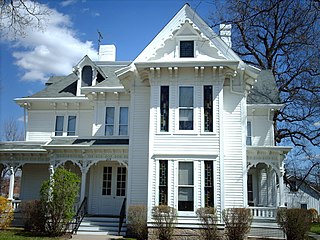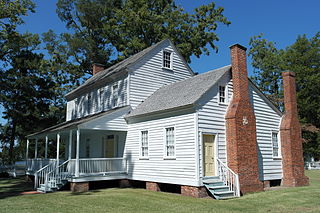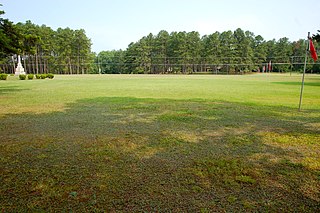
Bath is a town in Beaufort County, North Carolina, United States. Located on the Pamlico River, it developed a trade in naval stores, furs, and tobacco. The population was 249 as of 2010. North Carolina’s first town and port of entry, it was chartered on March 8, 1705.

Somerset Place is a former plantation near Creswell in Washington County, North Carolina, along the northern shore of Lake Phelps, and now a State Historic Site that belongs to the North Carolina Department of Natural and Cultural Resources. Somerset Place operated as a plantation from 1785 until 1865. Before the end of the American Civil War, Somerset Place had become one of the Upper South's largest plantations.

The House of the Seven Gables is a 1668 colonial mansion in Salem, Massachusetts, named for its gables. It was made famous by Nathaniel Hawthorne's 1851 novel The House of the Seven Gables. The house is now a non-profit museum, with an admission fee charged for tours, as well as an active settlement house with programs for the local immigrant community including ESL and citizenship classes. It was built for Captain John Turner and stayed with the family for three generations.

Old Salem is a historic district of Winston-Salem, North Carolina, United States, which was originally settled by the Moravian community in 1766. It features a living-history museum which interprets the restored Moravian community. The non-profit organization began its work in 1950, although some private residents had restored buildings earlier. As the Old Salem Historic District, it was declared a National Historic Landmark (NHL) in 1966, and expanded in 2016. The district showcases the culture of the Moravian settlement in North Carolina during the 18th and 19th centuries, communal buildings, churches, houses and shops.

Horne Creek Farm is a historical farm near Pinnacle, Surry County, North Carolina. The farm is a North Carolina State Historic Site that belongs to the North Carolina Department of Natural and Cultural Resources, and it is operated to depict farm life in the northwest Piedmont area c. 1900. The historic site includes the late 19th century Hauser Farmhouse, which has been furnished to reflect the 1900-1910 era, along with other supporting structures. The farm raised animal breeds that were common in the early 20th century. The site also includes the Southern Heritage Apple Orchard, which preserves about 800 trees of about 400 heritage apple varieties. A visitor center includes exhibits, a gift shop and offices.

Carl Sandburg Home National Historic Site, located at 81 Carl Sandburg Lane near Hendersonville in the village of Flat Rock, North Carolina, preserves Connemara, the home of Pulitzer Prize-winning poet and writer Carl Sandburg. Though a Midwesterner, Sandburg and his family moved to this home in 1945 for the peace and solitude required for his writing and the more than 30 acres (120,000 m2) of pastureland required for his wife, Lilian, to raise her champion dairy goats. Sandburg spent the last twenty-two years of his life on this farm and published more than a third of his works while he resided here.
The Alice Freeman Palmer Memorial Institute, better known as Palmer Memorial Institute, was a school for upper class African Americans. It was founded in 1902 by Dr. Charlotte Hawkins Brown at Sedalia, North Carolina near Greensboro. Palmer Memorial Institute was named after Alice Freeman Palmer, former president of Wellesley College and benefactor of Dr. Brown.

The Palmer-Marsh House is a historic house museum and National Historic Landmark on Main Street south of Carteret Street in Bath, North Carolina. Built in 1744, it is one of the oldest residences in North Carolina, and is a well-preserved example of a large colonial town house with a commercial space built in. It was declared a National Historic Landmark in 1970. It is now a North Carolina state historic site, and is open for tours.

Bentonville Battlefield is a North Carolina state historic site at 5466 Harper House Road in Johnston County, North Carolina. It belongs to the North Carolina Department of Natural and Cultural Resources and is the site of the 1865 Battle of Bentonville, fought in the waning days of the American Civil War. It was declared a National Historic Landmark in 1996.

The Thomas Wolfe House, also known as the Thomas Wolfe Memorial, is a state historic site, historic house and museum located at 52 North Market Street in downtown Asheville, North Carolina. The American author Thomas Wolfe (1900–1938) lived in the home during his boyhood. The house was designated a National Historic Landmark in 1971 for its association with Wolfe. It is located in the Downtown Asheville Historic District.

Edenton Historic District is a national historic district located at Edenton, Chowan County, North Carolina. The district encompasses 342 contributing buildings, 4 contributing sites, and 3 contributing structures. It includes several buildings that are individually listed on the National Register. The Lane House, possibly the oldest surviving house in North Carolina, is owned by Steve and Linda Lane and is located within the district. Also located in the district are the Dixon-Powell House, William Leary House, and Louis Ziegler House designed by architect George Franklin Barber.

The Mordecai House, built in 1785, is a registered historical landmark and museum in Raleigh, North Carolina that is the centerpiece of Mordecai Historic Park, adjacent to the Historic Oakwood neighborhood. It is the oldest residence in Raleigh on its original foundation. In addition to the house, the Park includes the birthplace and childhood home of President Andrew Johnson, the Ellen Mordecai Garden, the Badger-Iredell Law Office, Allen Kitchen and St. Mark's Chapel, a popular site for weddings. It is located in the Mordecai Place Historic District.

The Harry S. Truman Historic District is a National Historic Landmark District encompassing sites closely associated with US President Harry S. Truman in Independence, Missouri. It includes the Truman Home at 219 North Delaware, Truman's home for much of his adult life and now a centerpiece of the Harry S. Truman National Historic Site, and the Truman Presidential Library. The district was listed on the National Register of Historic Places in 1971, and was designated a National Historic Landmark in 1974. When first listed, the district included only the two buildings and a corridor joining them. It was substantially enlarged in 2011 to include more sites and the environment in which Truman operated while living in Independence.

Bonner House is a historic home located at Bath, Beaufort County, North Carolina. It was built about 1835, and is a two-story frame dwelling with a one-story wing and rear shed addition. It sits on a brick pier foundation and has a side-hall plan. It is on land once owned by John Lawson, explorer and founder of Bath.

The House in the Horseshoe, also known as the Alston House, is a historic house in Glendon, North Carolina in Moore County, and a historic site managed by the North Carolina Department of Natural and Cultural Resources' Historic Sites division. The home, built in 1772 by Philip Alston, was the site of a battle between loyalists under the command of David Fanning and patriot militiamen under Alston's command on either July 29 or August 5, 1781. The battle ended with Alston's surrender to Fanning, in which Alston's wife negotiated the terms with the loyalists.

Halifax Historic District is a national historic district located at Halifax, Halifax County, North Carolina, US that was listed on the National Register of Historic Places in 1970. It includes several buildings that are individually listed on the National Register. Halifax was the site of the signing of the Halifax Resolves on April 12, 1776, a set of resolutions of the North Carolina Provincial Congress which led to the United States Declaration of Independence gaining the support of North Carolina's delegates to the Second Continental Congress in that year.

Thompson's Bromine and Arsenic Springs, also known as Healing Springs, is a historic mineral spring resort and national historic district located near Crumpler, Ashe County, North Carolina. The district encompasses 10 contributing buildings and 1 contributing site. They include the octagonal plan spring house and frame double cabin, frame bath house, a long frame cabin structure, 5 cabins, and a double cabin. The Bromine-Arsenic Springs Hotel was constructed in 1887 and burned to the ground in 1962; its former location is considered an archaeological site.

William Rea Store is a historic commercial building located in the Murfreesboro Historic District at Murfreesboro, Hertford County, North Carolina. It was built about 1790, and is a two-story, three bay, brick building with a one-story, three bay wing. It is one of the oldest commercial buildings in North Carolina. It was built by William Rea, a wealthy Boston merchant.

Harper House is a historic home located near Four Oaks, North Carolina, Johnston County, North Carolina. It was built about 1855, and is a two-story, three-bay, vernacular Greek Revival style frame dwelling. It sits on the original brick pier foundation and has a hipped roof and interior end chimneys. The front facade features a two-story pedimented portico. The house served as a Union field hospital during the Battle of Bentonville and is located adjacent to the Bentonville Battlefield state historic site visitors center, which offers tours of its interior. It was bought by the state in 1957. Before the state's acquisition of the property, it was privately owned by the Dunn family, and before them the Thorntons. It served as a home for 6 of the Harper children, and two of the Harpers grandchildren during the battle.





















